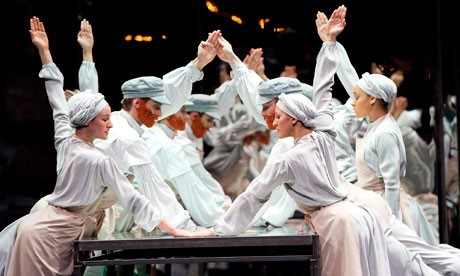
This Pet Shop Boys and Javier de Frutos collaboration sounds like the 1980s, looks like the 1920s, acts like the 1890s and feels as flat as the present. The commissioned score, mixing live orchestra with electronica, is sometimes like epic film music, albeit with an obtrusive beat, and sometimes like a TV theme tune, as catchy and kitschy as a soap opera jingle. In their own songs, the PSB frequently find poetry in the banal; here they aim for greater dramatic effect and end up sounding more ordinary.
Katrina Lindsay's boldly imaginative designs feature the saturated colours and blocky shapes of 20s Soviet constructivist art – apt for the opening scene, in which workers form a production line of pistoning limbs. The piece itself is based on a story by Hans Christian Andersen, and like a 19th-century ballet, it features a princess, a suitor, a villain, a fantastical transformation scene, and a celebratory wedding finale. Clemmie Sveaas makes a gutsy princess, bopping away in her bedroom before her father trades her in marriage to whoever can show him the most incredible thing. The winner is humble artist Aaron Sillis, whose extraordinary clock displays marvellous scenes. But when big-booted baddie Ivan Putrov smashes the clock, a jury agrees that to destroy such a wonder is more incredible still. There's a happy finish though, cleverly rendered as a variation of the opening scene.
Buried inside this big multimedia production, an illuminating fable is waiting to get out; one that marries a vision of love with a vision of creativity. You glimpse it in the central scene depicting a world of wonders, but mostly this entirely postmodern piece – which is stuffed with references to other choreographers, from George Balanchine to Busby Berkeley to Bob Fosse – is so torn between sincerity, irony, homage and parody, that it doesn't quite hit any of those spots. Some great dancers, though.

